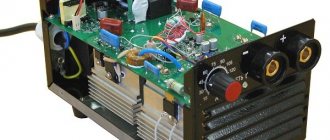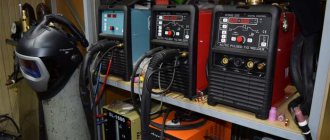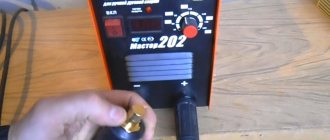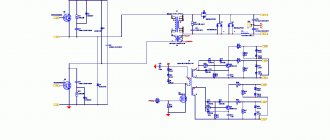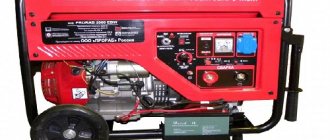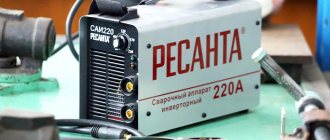Modern samples of welding equipment, through which so-called pulse welding is implemented, are presented on the domestic market with inverter-type products. This type of welding machine is positioned as high-frequency electronic converters capable of working with various types of consumables.
In pulsed welding, both piece coated electrodes and welding wire or special additives used in semi-automatic welding are used. Unlike conventional step-down transformers, a pulse welding machine is characterized by a special approach to the formation of a working arc.
Pulse welding - what is this technique?
Pulse welding, otherwise known as MIG, is a variation of arc welding in which continuous welds are created by melting at specific points and then coating them. This technique is an alternative to traditional electric arc technology, which is characterized by low productivity and poor weld quality. The peculiarity of pulsed-arc welding is that in addition to the main operating current, alternating pulses occur with fluctuations of up to 250 Hz.
Thanks to this, the power load increases and filler material is significantly saved, and the likelihood of lack of fusion is reduced. The main element of pulse welding is a pilot arc of medium power, which does not stop functioning in the intervals between repeated pulses and supplies only a small portion of current. The pilot arc has a special on/off mode, determined by the program, taking into account the nature of the metals, as well as the thickness of the edges and the location of the seams.
Heated at high temperatures, the arc melts the workpiece, then transferring it into the bath with minimal particle dispersion. This technique allows you to process even the thinnest metals without burning through them.
Varieties
Taking into account the type of materials being fused, there are 4 main types of MIG:
- Magnetic pulse. The elements are connected under high pressure, the seam is formed under the influence of temperatures and compression forces. It is based on the electromechanical principle of eddy currents. Used for cooking various materials with high productivity.
- Condenser. Welding machines have excellent parameters, a huge range of current strength and different power characteristics. Used for welding aluminum parts.
- Inertial. The peculiarity of this welding is the presence of a powerful flywheel powered by an electric motor. Kinetic energy then flows to pulsed currents, provoking the occurrence of inertial resonance.
- Rechargeable. Welding devices are equipped with alkaline batteries that instantly stabilize short circuits that occur during the ignition of the electrode.
TIG welding, which uses argon electrodes, is also often used. The TIG technique is an excellent option for processing non-ferromagnetic metals. Currently, laser welding is very popular, which is mainly used in the field of electronic technology and radio electronics.
To work with dental alloys made of titanium in the field of dental prosthetics, arc microwelding devices are used, which work no less efficiently than laser devices. Micropulse welding ensures reliable joints.
Areas of application of pulse welding
Pulse arc welding is widely used in modern industries. Most often, the technology is used to connect modern pipelines, which must have the most durable and reliable connection. In addition, pulsed spot welding is in great demand for:
- construction of bridges and other structures subject to high loads;
- assembly of car bodies;
- production of train cars;
- production of cranes, earth-moving equipment;
- creation of ship hulls and skins.
This type of welding work allows you to connect even the most whimsical and capricious metals with workpiece thicknesses from 1 mm to 5 cm. It copes well with even the most complex butt welds. Such devices can be used both in large industries and in car services and small workshops.
Features of circuit solutions
The electronic circuit of the inverter device contains several blocks, each of which is responsible for a certain step in the overall conversion of the input voltage. Due to this distribution of functions, it is possible to generate current pulses of significant magnitude that support an electrical discharge of the required quality.
The converter chain of the pulse device begins with a low-frequency rectifier, which is supplied with a mains voltage of 220 Volts (50 Hertz). At its output, the pulsations formed after rectification are smoothed out by a capacitor filter.
After the filter, the direct current is supplied directly to the inverter (a block of high-frequency transistor switches), which switches the rectified input voltage with a frequency of about 55-75 kilohertz. Due to this, the rectified voltage is converted back into alternating current, but at a higher frequency.
At the next stage, alternating voltage is supplied to a step-down transformer, which makes it possible to connect a large current load to the secondary winding.
At the output of the transformer circuit, the voltage is rectified again in order to organize a given welding current mode, supplied to the holder with the electrode.
The correct functioning of the entire complex of converter modules is ensured by feedback and control units built into the system.
Even a superficial acquaintance with the circuit of an inverter device allows us to conclude that the entire chain of transformations is used for one purpose - to obtain a current of the required power and quality at the output of the device.
Advantages and disadvantages of the technique
A material processing method such as MIG has many advantages compared to other technologies:
- high penetration rate;
- the ability to connect the thinnest aluminum blanks;
- excellent weld quality;
- the ability to control and minimize metal crystallization;
- minimal risk of weld deformation and material burnout;
- saving wire and gas;
- saving costs on consumables;
- stability of working positions;
- precise control of the moment of melting;
- eliminating the risk of short circuit during startup;
- elimination of scale splashing and smoke formation;
- low heat input.
MIG dx-808 technology is characterized by high productivity, versatility, reliability and safety, making it ideal for welders with or without extensive experience.
However, there are certain disadvantages that you need to know about before starting work. The disadvantages of MIG welding include the following:
- converter overheating;
- the ability to work only in small areas;
- lack of models for household use;
- difficulties in care;
- high price.
The advantages of pulse welding significantly outweigh its disadvantages, which is why it is in great demand.
Advantages
The advantages of pulse welding equipment include the following properties:
- high accuracy of tracking the moment of melting of the filler material (formation of the weld pool) and maintaining the specified parameters throughout the entire range of operating modes;
- at the moment of ignition of the arc during pulse welding, there is no short circuit, which has a positive effect on welding procedures (less spatter is generated);
- independence of the positive characteristics of the welding process from the type of consumables used.
Thanks to system control in inverter-pulse welding machines, it is possible to implement automatic control of modes determined by such parameters as metal thickness, wire feed speed and current strength.
Pulse devices use innovative technologies that make it possible to obtain an effective arc with the possibility of halving production costs.
Despite the relatively high cost indicators, samples of pulse welding equipment are used not only in mass production, but also in households.
They are most popular among professionals because they allow them to perform any welding work with higher quality seam joints.
Pulse welding technology
The entire semi-automatic pulse welding process occurs in several stages:
- A small drop of molten metal consumable material is separated under a powerful pulse and placed on top of the workpiece.
- The current is reduced to a level that is sufficient to maintain the arc.
- The metal in the weld pool instantly cools down.
- The above actions are repeated cyclically.
For proper operation of the machine, a setup must be made, which includes performing the following actions:
- Provide good grounding necessary for reliable contact during the pulse period when high currents occur.
- Make sure all cables are connected correctly.
- Reduce the inductance value by using power cables up to 15 m long.
- Increase cooking efficiency by avoiding cables wrapping around electrically conductive objects.
It is very important to correctly adjust the shape of the pulse wave during MIG, since this affects the quality of the weld penetration and the aesthetics of the weld.
Pulse welding: advantages and capabilities.
“Welding is the process of creating a permanent connection as a result of melting the edges, the formation of a common weld pool and its subsequent crystallization” - this is the definition of a welding process well known to many.
As you know, welding in its current form was invented in the 30s and 40s of the last century. Over such a long period of time, the once simple process has taken on the form of a complex technological operation, the non-consumable carbon electrode has been replaced by consumable welding wire, transformers have given way to electronics and inverters, and the quality of connections has improved through the use of various gas and powder protection.
Recently, semi-automatic welding with consumable wire in a shielding gas environment has become most widespread due to its ease of use, a wide range of welded materials and thicknesses, the low price of equipment with its small dimensions and the possibility of automation and robotization. Many welders, both private traders, small offices and workers of industrial giants on a national scale, have opted for semi-automatic machines, emphasizing the increased efficiency (compared to the previously used manual arc welding with a consumable electrode), unpretentiousness in work and a significant reduction in seam defects in the output of products.
Progress does not stand still, which means that the already easy-to-use machines for semi-automatic welding are acquiring new technologies every year to improve the welding process and prevent the occurrence of defects and stresses in the welding seam.
| Aluminum welding in pulse mode using CEA DIGITECH VISION PULSE 5000 |
One such technology is the possibility of pulse welding.
The process of creating continuous welds by melting metal with controlled transfer "one pulse - one drop" is called pulse welding.
Using a pulsed arc as a heat source, you can significantly expand the capabilities of traditional gas shielded welding.
Pulsed MIG/MAG welding is a variation of the conventional MIG/MAG welding process in which the current is pulsed at a frequency. Some modern devices allow you to adjust the pulse frequency. Since the feed speed of the electrode wire is not equal to the speed of its melting, an additional pulse was introduced to control metal transfer when working at low currents by applying high current pulses of short duration. The cycle consists of applying repeated pulsed current during a constant background current to produce a droplet at the end of the electrode.
Electrodynamic forces, sharply increasing, narrow the neck of the drop, throwing it into the weld pool. In this case, you can use both single and a whole group of pulses.
The stability of the entire MIG/MAG process directly depends on the ratio of the duration and magnitude of the pulses and pauses between them.
By selecting the pulse and arc current, you can speed up the melting of the electrode wire and help change the shape and size of the weld. Finally, you can reduce the lower limit of the welding current, which is responsible for the stability of the arc.
Controlled metal transfer helps improve weld quality. This method is one of the best and most effective. During pulse welding, there is absolutely no spattering and no lack of fusion is formed.
Compared with welding with a non-consumable electrode, pulsed welding makes it possible to increase the productivity of the process by 3-8 times and significantly reduce welding deformations with almost the same quality of welded joints. Pulse welding can be used for critical structures made of different grades of steel, aluminum, copper, nickel alloys and titanium with a thickness of 1 to 50 mm when making seams in all spatial positions. Due to the high spatial stabilization of the arc and the possibility of using a long electrode extension, this process can be successfully used for welding butt joints of thick sheet materials with narrow-slot edge preparation.
Pulse welding is most widespread for joining aluminum alloys with a thickness of ≥1.5 mm and special steels with a thickness of >1 mm.
For each welding current, the optimal frequency and pulse energy must be selected. A frequency of 50 Hz should be used at low currents when using a frequency of 100 Hz is not possible. For currents above 70-100 A, a frequency of 100 Hz should be used, since at a frequency of 50 Hz the scaliness of the seam, its porosity and smoke formation increase.
Modern welding machines allow the use of a wide range of pulse amplitudes of various durations and waveforms at frequencies from several hertz to several hundred hertz. The amplitude and duration of the pulse, when properly combined, creates an arc capable of melting and detaching a drop of electrode wire with a diameter close to the thickness of that wire.
Such an arc in pauses between pulse excitations does not have a significant effect on the depth of metal melting. Due to this, a stable burning of the arc in space is achieved, the quality of welding is improved: there is no spattering of the molten metal of the wire, craters from the weld points are completely eliminated while reducing the required overlap areas at the weld site. Choosing an appropriate ratio of arc currents (pulse and standby) can also significantly speed up the welding process, but this process is a complex operation. The height and duration of the pulse depend on the composition of the wire, its diameter and, to a lesser extent, on the composition of the shielding gas.
Devices with a synergetic control system are most suitable for monitoring pulse parameters. Such devices allow you not only to configure the basic parameters of the welding process: the amount of background and pulse current, their flow time, arc length, etc., but also to build on preset programs designed specifically for specific data, both the material being welded and the ones used. consumables": composition of gas protection and filler wire. These settings are clearly visible in the CEA DIGITECH menu images below.
Menu for selecting programs for welding various materials of the DIGITECH device
The main advantages of the pulsed MIG/MAG welding mode:
• It allows you to achieve smooth, spatter-free welding at medium currents (50-150A), which are otherwise only suitable for short-arc welding with non-periodic metal supply into the welding zone and, as a result, the appearance of metal spatter.
• Pulse transfer is intermediate between jet transfer and short arc welding, which can be too "cold" (due to the intermittent generation of the electric arc, the arc is effectively 'out' between each melting cycle). This makes it ideal for thick welds where control of heat input is required, but for which the jet transfer would be too hot.
• Pulsed MIG welding allows you to weld at higher speeds where submerged arc or jet transfer are not applicable.
• Possibility of transition from droplet transfer to fine-droplet and jet transfer.
Double impulse
| Double pulse aluminum welding with CEA DIGITECH VISION PULSE 5000 |
The essence of the MIG/MAG process with double pulses is the modulation of the high-frequency welding carrier current generated by the power inverter with low-frequency pulses that are generated by the secondary inverter. In this case, the shape of the pulse and the current/pause ratio change significantly.
By changing the shape of the pulse and the angle of inclination of the pulse wave front, it becomes possible to obtain controlled small-droplet transfer in short-circuit mode.
The short circuit mode is characterized by a smooth flow of a drop from the end of the electrode wire into the weld pool.
The size of the drop practically corresponds to the diameter of the electrode wire, which makes it possible to reduce the size of the liquid metal bath and improve the spreading of the drop in the bath. Reducing the pool size leads to proper, uniform formation of the back bead, improving the quality of the root pass and improving conditions for welding thin metal.
When working with T-welds, a double current pulse makes it possible to obtain a seam with a concave leg and avoid the appearance of possible stress concentrators in the fusion zone.
As for the welding mode settings system, it primarily depends on the purpose of the device, the price and, if possible, preset programs that expand the functions. Thus, the CEA DIGITECH machine, in addition to a clear, intuitive menu, has flexible settings for both pulse and double pulse welding parameters at all stages of the process.
| Selecting double pulse welding mode | Current and voltage adjustment screen |
Adjustment parameters are displayed in squares, the adjustable parameter is highlighted in green.
From left to right: pre-gas, starting speed, hot start, initial current, initial arc length, initial rise, final decay, final current, final arc length, arc stretch, post-weld gas.
Double pulse diagram with settings: first modulation (I1 to I2), double pulse current difference, double pulse duration, double pulse balance, double pulse frequency, second modulation (I2 to I1).
Adjustment of dynamics/pulse frequency for ULTRASPEED mode (special function of SEA semi-automatic devices).
In the CEA line, the following devices have the ability to perform semi-automatic MIG/MAG welding using pulse/double pulse: DIGISTAR 250, DIGITECH VISION PULSE 5000. You can familiarize yourself with the description of the devices by simply clicking on the model of interest.
Necessary equipment and materials
The welding machine has a simple design, so if you have the necessary equipment and materials, you can build a device for pulse welding with your own hands. To do this you need to prepare the following details:
- low frequency voltage rectifier;
- high-frequency transformer type converter;
- inverter unit with transistors;
- transformer with step-down windings;
- Control block;
- power filter;
- working shunt;
- wire feed system.
All components are easy to find and are inexpensive. After preparing the equipment, all that remains is to connect the parts according to the diagram. When choosing parts, you need to pay attention to their quality. You especially shouldn’t skimp on transistors, since they are the ones that break down most often.
Operating principle
As for the direct design of inverter-pulse type products, the difference from conventional devices is expressed in the presence of a special built-in control unit in their composition.
A characteristic feature of the modification of welding machines with a pulsed welding mode is the presence of a built-in converter operating at high frequencies.
A typical circuit of such a device ensures that the required amount of current is obtained in the secondary winding by means of its pulse conversion. The voltage obtained at the output is once again converted into a form convenient for welding (straightened or brought to the required form).
Purely structurally, the inverter is a pulse-type step-down transformer with a number of additional functions that ensure the functionality of the electronic converter itself and its control circuit.
The effective values of alternating voltage in the secondary circuit of inverter devices can be reduced to values of the order of 60-70 Volts. This guarantees the ability to connect to them a current load of up to 110-130 Amperes.
The electronics built into the pulse apparatus allow you to control its operation and maintain the required welding pattern (argon mode or any other).
In terms of their complexity, inverter semi-automatic machines are superior to all known types of welding machines, but at the same time, with their help, it is possible to achieve a higher quality of connections.
It should also be noted that independent work with pulsed equipment, due to its reliability and high level of automation, is accessible even to novice welders.
